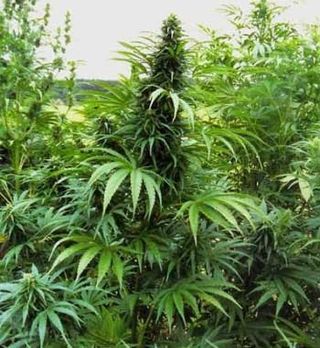Psychiatry
Marijuana and Weight: A Plant With Virtues to Be Discovered?
The "world's most used illegal drug" has paradoxical effects on body weight
Posted April 25, 2016

English novelist and poet Rudyard Kipling (1865-1936), in his 1923 lecture Surgeons and the Soul, given to the Royal College of Surgeons, said, “I am, by calling, a dealer in words; and words are, of course, the most powerful drug used by mankind.” For Kipling, who won the Nobel Prize for Literature, words may have been most powerful, but there are many millions who tout the power of the drug marijuana. It has been estimated, for example, that 178 million people age 15 to 64 worldwide used marijuana at least once in 2012 (Whiting et al, JAMA, 2015). With the growing movement to legalize marijuana nationally, there is every reason to believe the rates are increasing.
The scientific name for marijuana is Cannabis sativa, but not all Cannabis sativa is marijuana: hemp is also in this family and has the same five-pointed leaf but does not have its psychoactive properties. The “defining difference” between the two is in their cultivation: marijuana tends to grow in hotter climates while hemp is cultivated in the north and in cooler climates. (Chasteen, Getting High: Marijuana Through the Ages, 2016, p. 13) Throughout history, hemp has been grown for cloth, jewelry, and even canvases for artwork.
The major psychoactive ingredient in marijuana is delta-9 tetrahydrocannabinol or THC, the most researched of one of 100 cannabinoids in the cannabis plant. There are preparations from the herb (marijuana), cannabis resin (hashish), or cannabis extract (hashish oil.) (Reuter and Martin, 2016, Clinical Pharmacokinetics). Marijuana can be smoked, drunk in tea, eaten in food such as the proverbial brownies, or inhaled in an e-cigarette vaping system. Cannabis is a fat-soluble molecule that crosses both the placenta and the blood-brain barrier and accumulates in adipose tissue where its half-life can from last days to more than a week. (Haelle, quoting Schizer, Clinical Psychiatric News, 2015)
Historian Chasteen (2016) notes historically that marijuana has been used globally, particularly for spiritual rather than recreational use—“more as a hallucinogen than a euphoriant.” (p. 5) He reports it came into the U.S. only around 1900, probably from Mexico. Chasteen writes that marijuana initially was seen as a “minor poison by comparison to alcohol,” (p. 19) whose prohibition came into effect in 1919, and it did not come into U.S. consciousness until the 1930s when it was considered the “devil’s weed.”(p.4) There are many slang terms for marijuana, but the Oxford English Dictionary (OED) notes the word “weed” was first mentioned for marijuana back in the late 1920s.

Harry Anslinger, then head of the Federal Bureau of Narcotics, touted the dangers of marijuana use and made marijuana illegal (and included hemp!) with the Marihuana Tax Act of 1937. Anslinger’s negative assessment was depicted in the 1930s propaganda (and later 1960s cult classic) film Reefer Madness. It was not until the countercultural movement of the late 1960s and early 1970s that marijuana use in the U.S. reached its heyday and became the “world’s most used illegal drug.” (Chasteen, p. 42, 2016)
Though the word “munchie” first appeared in English in the early 1900s to signify chocolate, according to the OED, it later came to represent any snack food and by the late 1960s, specifically the “powerful feelings of hunger” after taking marijuana. Anecdotally, those taking marijuana described strong cravings and feelings of hunger as far back as ancient Hindu texts (Kirkham, International Review of Psychiatry, 2009). The symptoms of the “munchies” led researchers to become curious about the effects of marijuana on weight, including how it would affect those who suffer from cachexia, i.e., the reduced appetite and wasting due to cancer or HIV AIDS. The use of cannabis for medical conditions such as pain and nausea, though, dates back thousands of years B.C. in China and India. (Farrimond et al, Phytotherapy Research, 2011).

In the late 1980s, researchers found an endogenous cannabinoid signaling system within animals and humans that included cannabinoid receptors CB1 and CB2. Romero-Zerbo and Bermudez-Silva (Drug Testing and Analysis, 2014) report that CB1 receptors are found predominantly at nerve terminals and responsible for the psychotropic effects of THC, whereas CB2 are found mostly in immune cells. The CB1 receptors are the ones responsible for the hyperphagic (“munchies”) effects of the cannabinoids. In fact, the CB1 antagonist medication rimonabant was developed years ago as an anti-obesity medication but was ultimately withdrawn from the European markets even before approval in the U.S. because of unwanted psychiatric side effects including suicidal ideation and depression.

It is believed that the endocannabinoid system may be involved in the maintenance of our body’s homeostasis (food intake and energy balance, including lipid metabolism and glucose control) as well as in modulating our reward system in the brain. Kirkham (2009) reports that the endocannabinoids may be involved in food seeking and eating initiation, as well as in food “liking”—the hedonic aspect of eating and that CB1 gene variants might eventually be used to assess endocannabinoid functioning and the predisposition of some to overeating, overweight, and obesity. Medications like rimanobant make food less pleasurable. There is some suggestion that those with a weight problem may have a “dysregulated endocannabinoid system and targeting this system may ultimately be an effective anti-obesity medication.” (Romero-Zerbo and Bermúdez-Silva (2014) Farrimond et al, 2011 report that since marijuana increases both “appetitive behaviors” that decrease time between meals and “consummatory behaviors” that regulate the size of a meal, these different behaviors can be eventually “manipulated differently.”
While medications that block the CB1 receptor lead to weight loss, there is some suggestion that cannabis itself can lead to decreased weight. Le Foll et al (Medical Hypotheses, 2013), for example, speculate that chronic use of THC or some combination may lead paradoxically to weight loss “under carefully controlled circumstances” but cautioned against the use of smoked cannabis for obesity control because of health consequences associated with inhaling the smoke.
The literature, though, is confusing. In reviewing the connection between marijuana and body weight, Sansone and Sansone (Innovations in Clinical Neuroscience, 2014) found that a single marijuana cigarette tends to have no effect on food intake, whereas higher doses of two or three marijuana cigarettes increase caloric intake between meals. Dronabinol, a synthetic compound with the same effect as marijuana, is used medically to increase food intake but over time patients have developed tolerance to its effects. In general, marijuana can have negative effects in those compromised by illness such as cancer or AIDS: fatigue, somnolence, and even hallucinations. Recent studies are complicated because of the considerable individual variability among subjects as well as clinical trials for evidence-based research on work with cancer patients, for example, have investigated only oral formulations and not different modes of administration. (Reuter and Martin (Clinical Pharmacokinetics, 2016)

Samsone and Samsone speculate that contradictory findings regarding the relationship of weight to marijuana may be related to potentially confounding factors such as varying dose, frequency, other components of marijuana, various exercise levels, other medications prescribed or other drugs used, as well as differences between short and long term use of marijuana. Further, both marijuana and food compete for the same reward centers in the brain. They further speculate that marijuana may have a “broad spectrum regulatory effect”—increasing weight in those who are underweight but not in those with normal or increased weight.
Bersani et al (Drug Testing and Analysis, 2016) report on a trend on the internet of an increased use of cannabis for weight loss—reporting “appetite reduction and eating pattern modifications.” These authors speculate that this paradoxical effect may be due to the development of tolerance or to the presence of other compounds and caution against the health risks associated with this behavior.
Cluny et al (PLOS One, 2015), in experiments on mice, found that chronic exposure to THC led to reduced food intake in their mice and prevented high fat diet-induced increase in weight and fat accumulation. These researchers speculate that THC has direct effects on the microbiome of the gut (and not likely due to changes in gastric motility) and may be responsible for the decreased weight: those mice exposed to chronic THC had an increased ratio of Firmicutes to Bacteroidetes, as well as an increase in a mucin degrading bacteria involved in the regulation of mucus in the gastrointestinal tract.
In their comprehensive 2016 review in JAMA Psychiatry on the effects of marijuana on human behavior, Dr. Nora Volkow, Director of the National Institute on Drug Abuse (NIDA), and her colleagues write that the national trend to legalize marijuana “could trigger a broad range of unintended consequences.” They note that there have been decades of “ill-informed and porous legal and illegal drug regulations that have exacted a devastating public health toll from our society.”

Volkow et al suggest that the recent efforts to legalize and even normalize cannabis use are “being driven largely by a combination of grassroots activism, pharmacological ingenuity, and private profiteering, with a worrisome disregard for scientific evidence..." Further, over the years, the concentration of THC has increased dramatically from that of the 1960s, and cannabis has become potentially more dangerous. These researchers appreciate there are clearly gaps in our knowledge and support the need to clarify scientifically the aspects of cannabis exposure (e.g. age at initiation, quantity used, frequency of use, duration of use and potency of cannabis used) that may lead to increased risk.
Reports of troublesome effects, especially in certain vulnerable populations such as adolescents or those prone to psychosis, though, have been reported over the years. For example, psychiatrists Kolansky and Moore, in a series of articles in JAMA in the 70s (1971, 1972, 1975) presciently warned of a deleterious and toxic amotivational (though reversible over time once exposure ceased) syndrome they had found in adolescent and young adult patients who were heavy, chronic users of marijuana referred to them for consultation. Of note, Kolansky and Moore reported that their patients tended to be physically thin.
Both the benefits and risks of cannabis use remain controversial all these years later. Ralph Waldo Emerson (1803-1882), American essayist, lecturer, and abolitionist, asked in his 19th century lecture Fortune of the Republic, “What is a weed? A plant whose virtues have not yet been discovered…” A weed, though, according to the OED, is a herbaceous plant not valued for its use or beauty, growing wild and rank…” In that context, "weed," then, becomes a paradoxical slang term for marijuana. Evidence-based scientific research will ultimately tell whether marijuana will have other virtues, including for weight control.
For those interested in research on the uses of marijuana as a medical therapy to treat disease or reduce symptoms (e.g. nausea and vomiting due to chemotherapy for cancer; chronic pain or spasticity due to multiple sclerosis), see the comprehensive review by Whiting et al (JAMA 2015) or research done by Reuter and Martin (Clinical Pharmacokinetics, 2016.) There is also a new book Marijuana and Mental Health, edited by Michael T. Compton, M.D., MP.H. (2016, American Psychiatric Association Publishing, Inc.)





